57Fe Mössbauer Spectroscopy as a Tool for Study of Spin States and Magnetic Interactions in Inorganic Chemistry
Abstract
:1. Introduction
2. Extreme High Hyperfine Field and Ferromagnetic Interaction in Linear, Two-Fold Coordinated Single-Molecule Magnetic Iron Complexes
3. Temperature-Dependent Spin Transitions and Antiferromagnetic Interaction in Iron Phthalocyanines Loaded with Oxygen in the Solid State
4. Conclusions
Author Contributions
Funding
Institutional Review Board Statement
Informed Consent Statement
Data Availability Statement
Acknowledgments
Conflicts of Interest
References
- Kahn, O. Molecular Magnetism; VCH Publishers: New York, NY, USA, 1993. [Google Scholar]
- Itoh, K.; Kinoshita, M. Molecular Magnetism; Kodansha and Gordon & Breach: Tokyo, Japan; Amsterdam, The Netherlands, 2001. [Google Scholar]
- Sessoli, R.; Gatteschi, D.; Caneschi, A.; Novak, M.A. Magnetic bistability in a metal-ion cluster. Nature 1993, 365, 141–143. [Google Scholar] [CrossRef]
- Coronado, E. Molecular magnetism: From chemical design to spin control in molecules, materials and devices. Nat. Rev. Mater. 2019. [Google Scholar] [CrossRef]
- Bogani, L.; Wersdorfer, W. Molecular spintronics using single-molecule magnets. Nat. Mater. 2008, 7, 179–186. [Google Scholar] [CrossRef]
- Gatteschi, D.; Sessoli, R.; Villain, J. Molecular Nanomagnets; Oxford University Press: Oxford, UK, 2006. [Google Scholar]
- Sessoli, R.; Tsai, H.L.; Shake, A.R.; Wang, S.; Vincent, J.B.; Folting, K.; Gatteschi, D.; Christou, G.; Hendrickson, D.N. High-spin molecules: [Mn12O12(O2CR)16(H2O)4]. J. Am. Chem. Soc. 1993, 115, 1804–1816. [Google Scholar] [CrossRef]
- del Barco, E.; Kent, A.D.; Hill, S.; North, J.M.; Dalal, N.S.; Rumberger, E.M.; Hendrickson, D.N.; Chakov, N.; Christou, G. Magnetic Quantum Tunneling in the Single-Molecule Magnet Mn12-Acetate. J. Low Temp Phys. 2005, 140, 119. [Google Scholar] [CrossRef]
- Luenberger, M.N.; Loss, D. Quantum computing in molecular magnets. Nature 2001, 401, 789. [Google Scholar] [CrossRef] [Green Version]
- Cianchi, L.; Del Giallo, F.; Lantieri, M.; Moretti, P.; Spina, G.; Caneschi, A. Spin dynamics of the magnetic dimer [Fe(OMe)(dpm)2]2 studied using Mössbauer spectroscopy. Phys. Rev. 2004, B69, 014418. [Google Scholar] [CrossRef]
- Cianchi, L.; Del Giallo, F.; Lantieri, M.; Moretti, P.; Spina, G. Study of the [Fe(OMe)(dpm)2]2 dimer in the presence of a magnetic field by using Mössbauer spectroscopy. Hyperfine Interact. 2006, 168, 1115. [Google Scholar] [CrossRef]
- Zadrozny, J.M.; Xiao, D.J.; Atanasov, M.; Long, G.J.; Grandjean, F.; Neese, F.; Long, J.R. Magnetic blocking in a linear iron(II) complex. Nat. Chem. 2011, 5, 2013. [Google Scholar]
- Abbas, G.; Lan, Y.; Mereacre, V.; Wernsdorfer, W.; Clerac, R.; Buth, G.; Sougrati, M.T.; Grandjean, F.; Long, G.J.; Anson, C.E.; et al. Magnetic and 57Fe Mössbauer Study of the Single Molecule Magnet Behavior of a Dy3Fe7 Coordination Cluster. Inorg. Chem. 2009, 48, 9345–9355. [Google Scholar] [CrossRef]
- Molins, E.; Gich, M.; Tejada, J.; Grenèche J., M.; Macià, F. Zero-field quantum tunneling relaxation of the molecular spin in Fe8 observed by 57Fe Mössbauer spectrometry. Europhys. Lett. 2014, 108, 47004. [Google Scholar] [CrossRef]
- Kuzmann, E.; Homonnay, Z.; Nagy, S.; Nomura, K. Mössbauer Spectroscopy. In Handbook of Nuclear Chemistry; Vértes, A., Nagy, S., Klencsár, Z., Lovas, R., Rösch, F., Eds.; Springer: New York, NY, USA; Heidelberg, Germany, 2011. [Google Scholar]
- Gütlich, P.; Eckhard, B.; Trautwein, A.X. Mössbauer Spectroscopy and Transition Metal Chemistry; Springer: New York, NY, USA, 2011. [Google Scholar]
- Vértes, A.; Burger, K.; Korecz, L. Mössbauer Spectroscopy; Akadémiai Kiadó-Elsevier: Budapest, Hungary; Amsterdam, The Netherlands, 1979. [Google Scholar]
- Greenwood, N.N.; Gibb, T.C. Mössbauer Spectroscopy; Chapman & Hall: London, UK, 1971. [Google Scholar]
- Stevens, J.G.; Stevens, V.E. Mössbauer Effect Data Index (MERDI); Adam Hilger: London, UK, 1966–1979. [Google Scholar]
- Gonser, U. Mössbauer Spectroscopy. Springer: New York, NY, USA, 1975. [Google Scholar]
- Gütlich, P. Spin crossover in iron(II)-complexes. In Metal Complexes. Structure and Bonding; Springer: Berlin/Heidelberg, Germany, 1981. [Google Scholar]
- Dézsi, I.; Molnár, B.; Tarnóczi, T.; Tompa, K. On the magnetic behaviour of iron(II)-bis-(1,10 phenantroline)-thiocyanate between −190° and 30° C. J. Inorg. Nucl. Chem. 1967, 29, 2486. [Google Scholar] [CrossRef]
- Holynska, M. Single Molecule Magnets Single-Molecule Magnets: Molecular Architectures and Building Blocks for Spintronics; Wiley-VCH Verlag GmbH & Co.: Marburg, Germany, 2019. [Google Scholar]
- Reiff, W.M.; LaPointe, A.M.; Witten, E.H. Virtual Free Ion Magnetism and the Absence of Jahn−Teller Distortion in a Linear Two-Coordinate Complex of High-Spin Iron(II). J. Am. Chem. Soc. 2004, 126, 10206. [Google Scholar] [CrossRef]
- Kuzmann, E.; Szalay, R.; Vértes, A.; Homonnay, Z.; Pápai, I.; de Chatel, P.; Szepes, L. 157 T internal magnetic field in Fe[C(SiMe3)3]2 compound at 20 K. Hyperfine Interact. 2008, 185, 185–189. [Google Scholar] [CrossRef]
- Kuzmann, E.; Szalay, R.; Vértes, A.; Homonnay, Z.; Pápai, I.; de Chatel, P.; Klencsár, Z.; Szepes, L. Observation and interpretation of 157.5 T internal magnetic field in Fe[C(SiMe3)3]2 coordination compound. Struct. Chem. 2009, 20, 453–460. [Google Scholar] [CrossRef]
- Reiff, W.M.; Schulz, C.E.; Whangbo, M.-H.; Seo, J.I.; Lee, Y.S.; Potratz, G.R.; Spicer, C.W.; Girolami, G.S. Consequences of a Linear Two-Coordinate Geometry for the Orbital Magnetism and Jahn−Teller Distortion Behavior of the High Spin Iron(II) Complex Fe[N(t-Bu)2]2. J. Am. Chem. Soc. 2009, 131, 404. [Google Scholar] [CrossRef]
- Merrill, W.A.; Stich, T.A.; Brynda, M.; Yeagle, G.J.; Fettinger, J.C.; De Hont, R.; Reiff, W.M.; Schulz C., E.; Britt, R.D.; Power, P.P. Direct Spectroscopic Observation of Large Quenching of First-Order Orbital Angular Momentum with Bending in Monomeric, Two-Coordinate Fe(II) Primary Amido Complexes and the Profound Magnetic Effects of the Absence of Jahn− and Renner−Teller Distortions in Rigorously Linear Coordination. J. Am. Chem. Soc. 2009, 131, 12693–12702. [Google Scholar]
- Atanasov, M.; Zadrozny J., M.; Long, J.R.; Neese, F. A theoretical analysis of chemical bonding, vibronic coupling, and magnetic anisotropy in linear iron(II) complexes with single-molecule magnet behavior. Chem. Sci. 2013, 4, 139. [Google Scholar] [CrossRef]
- Zadrozny, J.M.; Atanasov, M.; Bryan, A.M.; Lin, C.-Y.; Rekken, B.D.; Power, P.P.; Neese, F.; Long, J.R. Slow magnetization dynamics in a series of two-coordinate iron(II) complexes. Chem. Sci. 2013, 4, 125. [Google Scholar] [CrossRef]
- Zadrozny, J.M.; Xiao, D.J.; Atanasov, M.; Long, G.J.; Grandjean, F.; Neese, F.; Long, J.R. Magnetic blocking in a linear iron(I) complex. Nat. Chem. 2013, 5, 577–581. [Google Scholar] [CrossRef]
- La Pointe, A.M. Fe[C(SiMe3)3]2: Synthesis and reactivity of a monomeric homoleptic iron(II) alkyl complex. Inorg. Chim. Acta 2003, 345, 359–362. [Google Scholar] [CrossRef]
- Kuzmann, E.; Zoppellaro, G.; Pechousek, J.; Cuda, J.; Klencsár, Z.; Homonnay, Z.; Tucek, J.; Szalay, R.; Pápai, M.; Machala, L.; et al. Ferromagnetic Coupling in an Fe[C(SiMe3)3]2/Ferrihydrite Hetero-Mixture Molecular Magnet. Eur. J. Inorg. Chem. 2014, 2014, 3178–3183. [Google Scholar] [CrossRef]
- Kuzmann, E.; Zoppellaro, G.; Pechousek, J.; Klencsár, Z.; Machala, L.; Tucek, J.; Homonnay, Z.; Cuda, J.; Szalay, R.; Pápai, M. Magnetic coupling and relaxation in Fe[N(SiPh2Me)2]2 molecular magnet. Struct. Chem. 2016, 28, 975–983. [Google Scholar] [CrossRef]
- Guyodo, Y.; Banerjee, S.K.; Penn, R.L.; Burleson, D.; Berquo, T.S.; Seda, T.; Solheid, P. Magnetic properties of synthetic six-line ferrihydrite nanoparticles. Phys. Earth Plan. Interiors 2006, 154, 222–233. [Google Scholar] [CrossRef]
- Kopelev, N.; Chechersky, V.; Nath, A.; Wang, Y.L.; Kuzmann, E.; Zhang, B.; Via, G.H. Encapsulation of Iron Carbide in Carbon Nanocapsules. Chem. Mater. 1995, 95, 19. [Google Scholar] [CrossRef]
- Kirner, J.F.; Dow, W.; Scheidt, R.W. Molecular Stereochemistry of Two Intermediate-Spin Complexes Iron(II) Phthalocyanine and Manganese(II) Phthalocyanine. Inorg. Chem. 1976, 15, 1685–1690. [Google Scholar] [CrossRef]
- Annese, E.; DiSanto, G.; Choueikani, F.; Otero, E.; Ohresser, P. Iron Phthalocyanine and Ferromagnetic Thin Films: Magnetic Behavior of Single and Double Interfaces. ACS Omega 2019, 4, 5076–5082. [Google Scholar] [CrossRef]
- Kuzmann, E.; Homonnay, Z.; Vértes, A.; Li, S.; Yin, H.; Kubuki, S.; Wei, Y.; Nath, A.; Chen, X.; Li, J. Mössbauer studies of the interaction of oxygen with solid β-Fe(II)-phthalocyanine. J. Solid State Chem. 2003, 170, 118–123. [Google Scholar] [CrossRef]
- Kuzmann, E.; Nath, A.; Chechersky, V.; Li, S.; Wei, Y.; Chen, X.; Li, J.; Homonnay, Z.; Gál, M.; Garg, V.K.; et al. Mössbauer Study of Oxygenated Iron-Phthalocyanines, a Precursor of Magnetic Storage Material. Hyperfine Interact. 2002, 139, 631–639. [Google Scholar] [CrossRef]
- Yin, H.; Kubuki, S.; Homonnay, Z.; Kuzmann, E.; Vértes, A.; Wei, Y.; Nath, A. A Mössbauer Study of the Low Spin-High Spin Transition of an Oxygen Adduct Formed in Solid β-Fe(II)Phthalocyanine. Open Inorg. Chem. J. 2008, 2, 69–72. [Google Scholar] [CrossRef]
- Kuzmann, E.; Homonnay, Z.; Mylonakis, A.; Yin, H.; Wei, Y.; Kovács, K.; Kubuki, S.; Klencsár, Z.; Vértes, A.; Nath, A. Mössbauer study of oxygen adducts in solid Fe(II) phthalocyanines. J. Phys. Conf. Ser. 2010, 217, 12029. [Google Scholar] [CrossRef]
- Kuzmann, E.; Pechousek, J.; Cuda, J.; Yin, H.; Wei, Y.; Homonnay, Z.; Klencsár, Z.; Horváth, A.; Machala, L.; Kubuki, S.; et al. Magnetic interaction in oxygenated alpha iron phthalocyanines. AIP Conf. Proc. 2014, 1622, 97–103. [Google Scholar]
- Scheidt, W.R.; Kadish, K.M. The Porphyrin Handbook; Kadish, K.M., Smith, K.M., Guilard, R., Eds.; Academic Press: San Diego, CA, USA, 2000; Volume 3, pp. 49–112. [Google Scholar]
- Hannah, S.; Lynch, V.; Guldi, D.M.; Gerasimchuk, N.N.; MacDonald, C.B.; Magda, D.; Sessler, J.L. Late First-Row Transition-Metal Complexes of Texaphyrin. J. Am. Chem. Soc. 2002, 124, 8416–8427. [Google Scholar] [CrossRef] [PubMed]

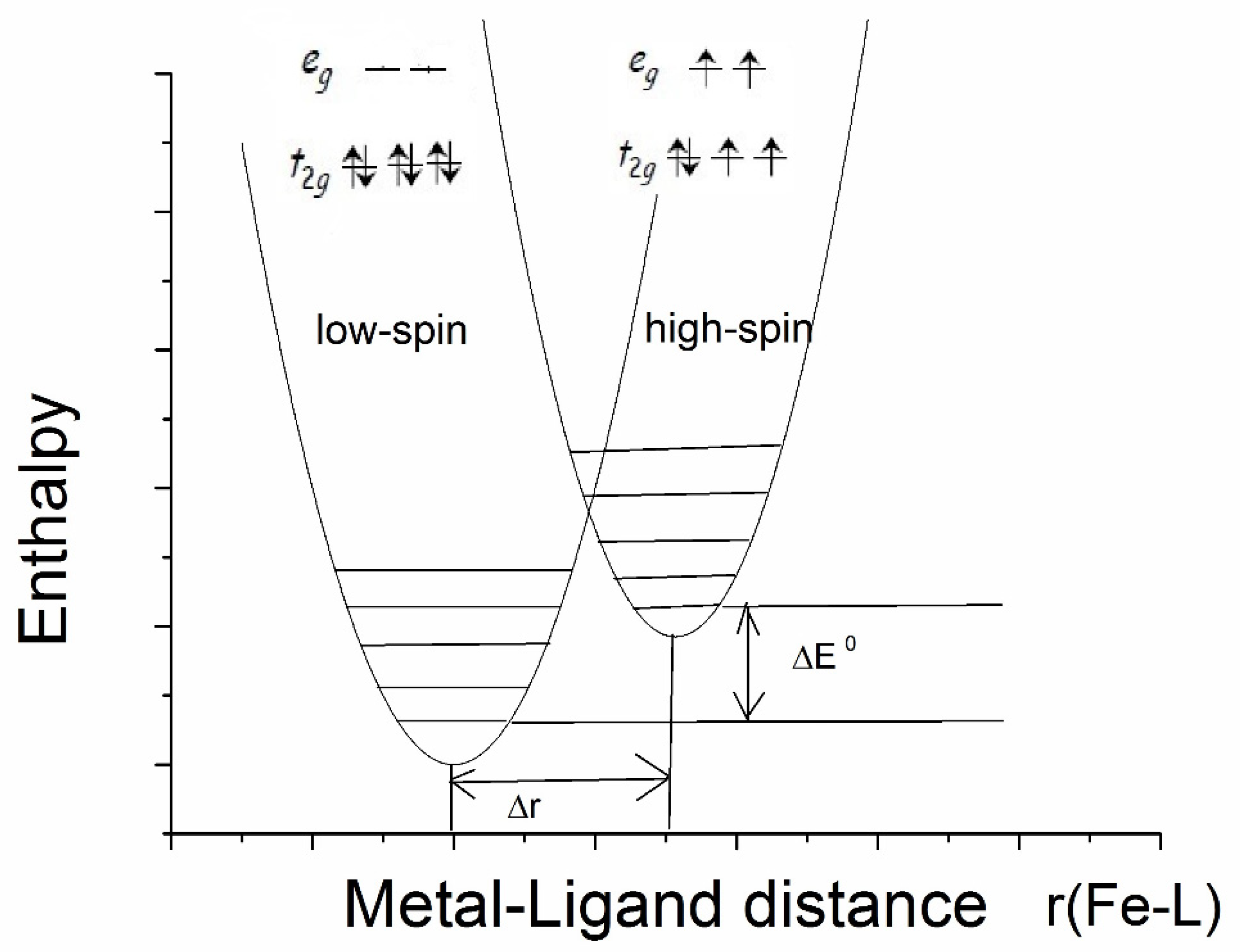
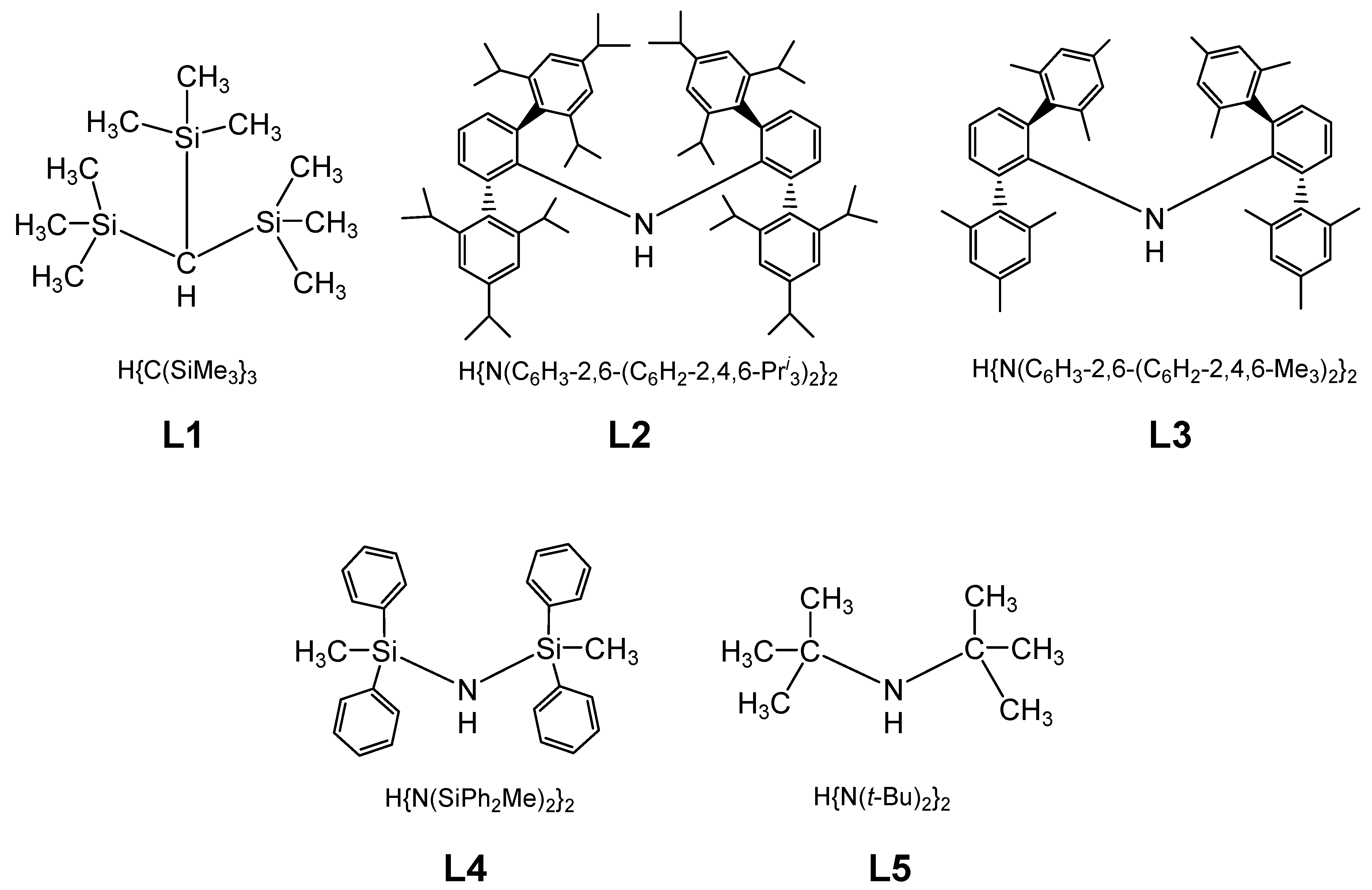

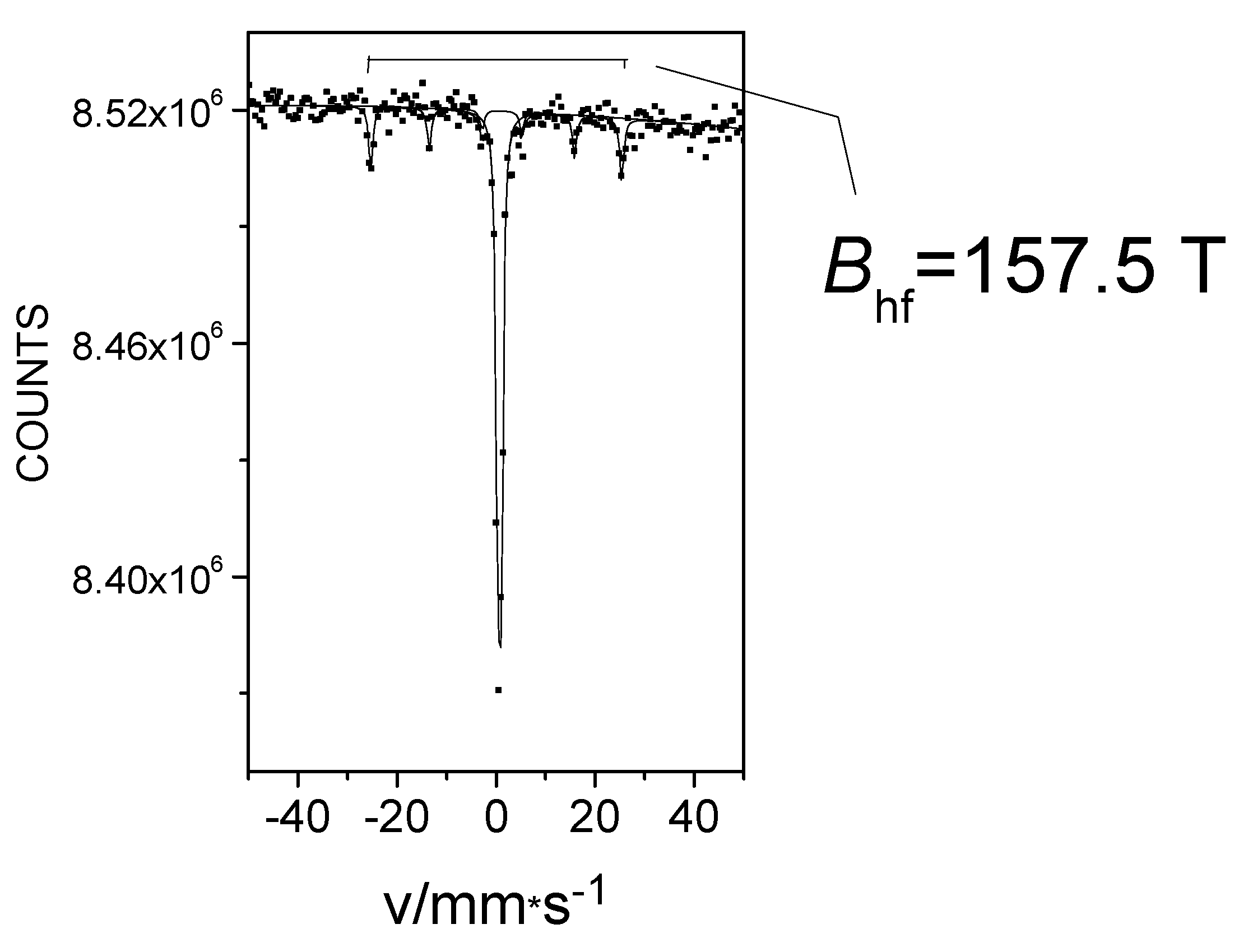
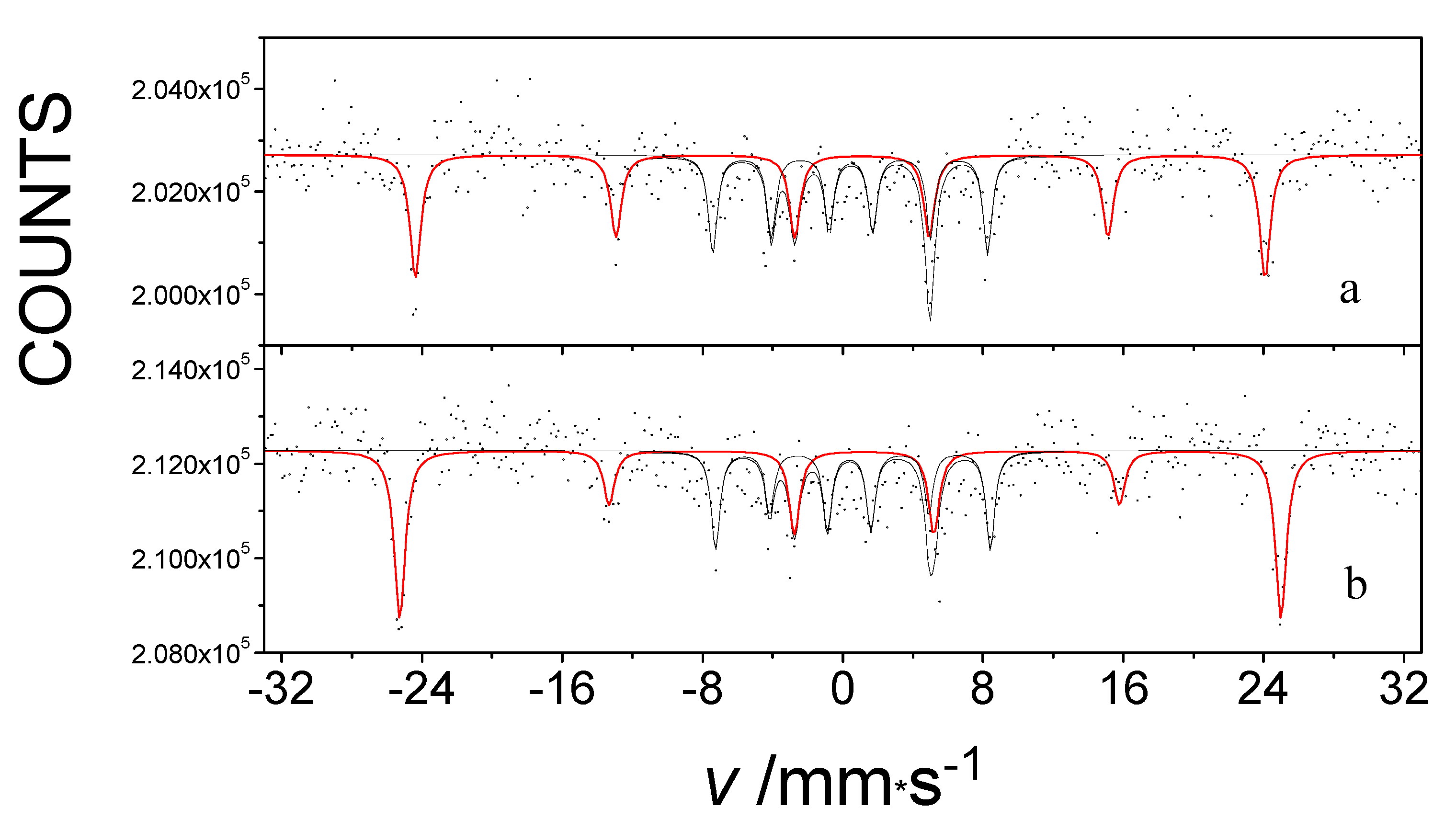

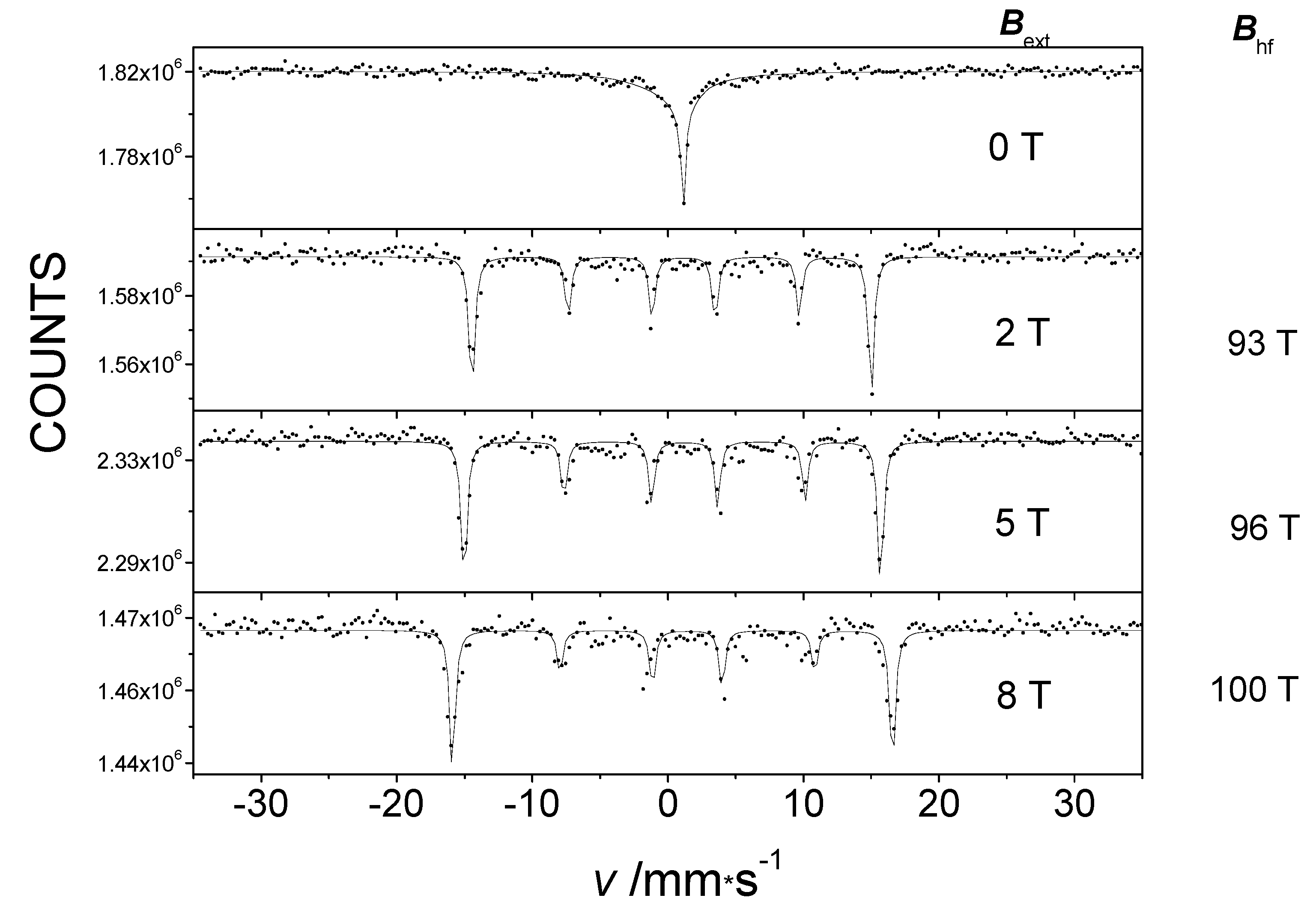
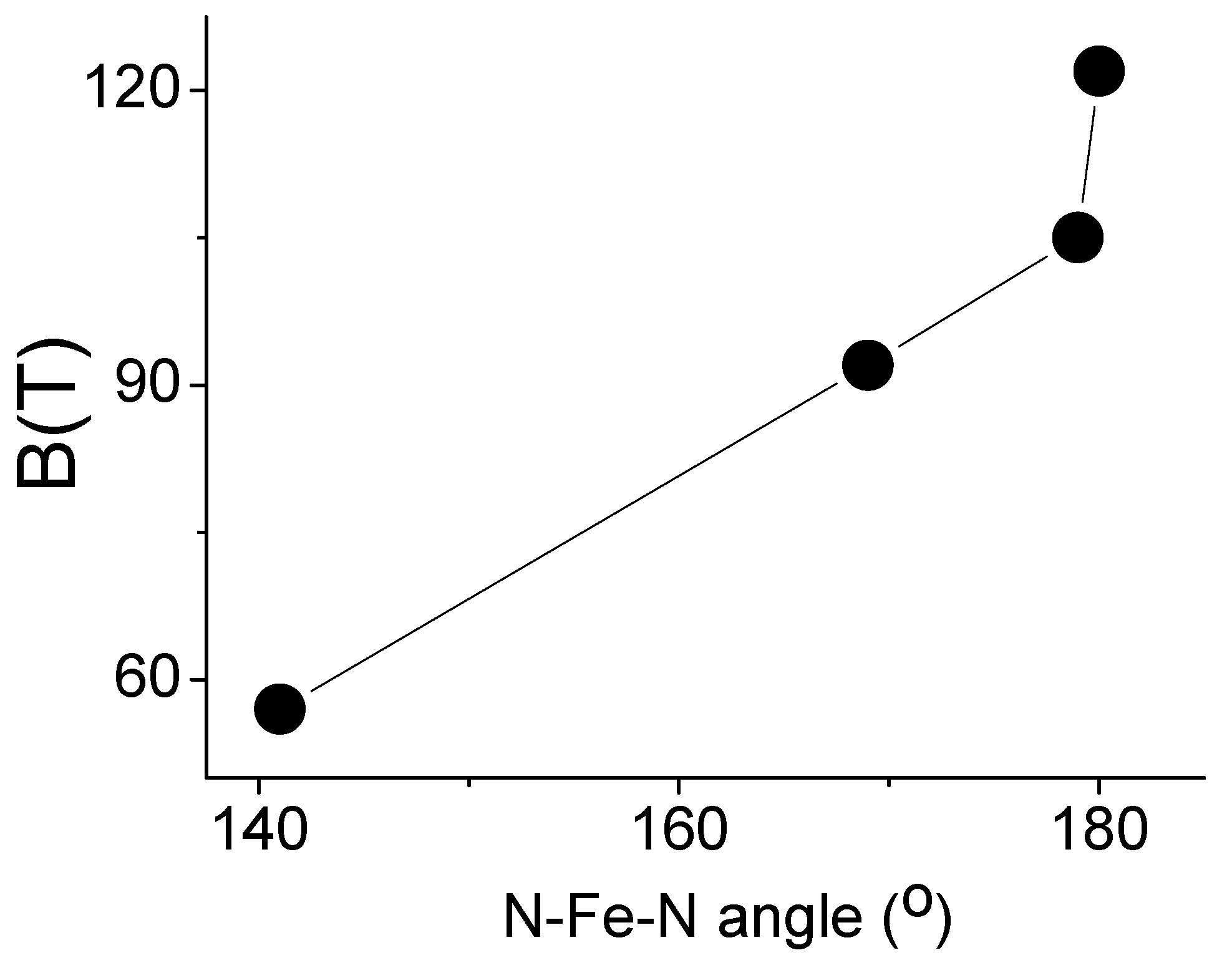

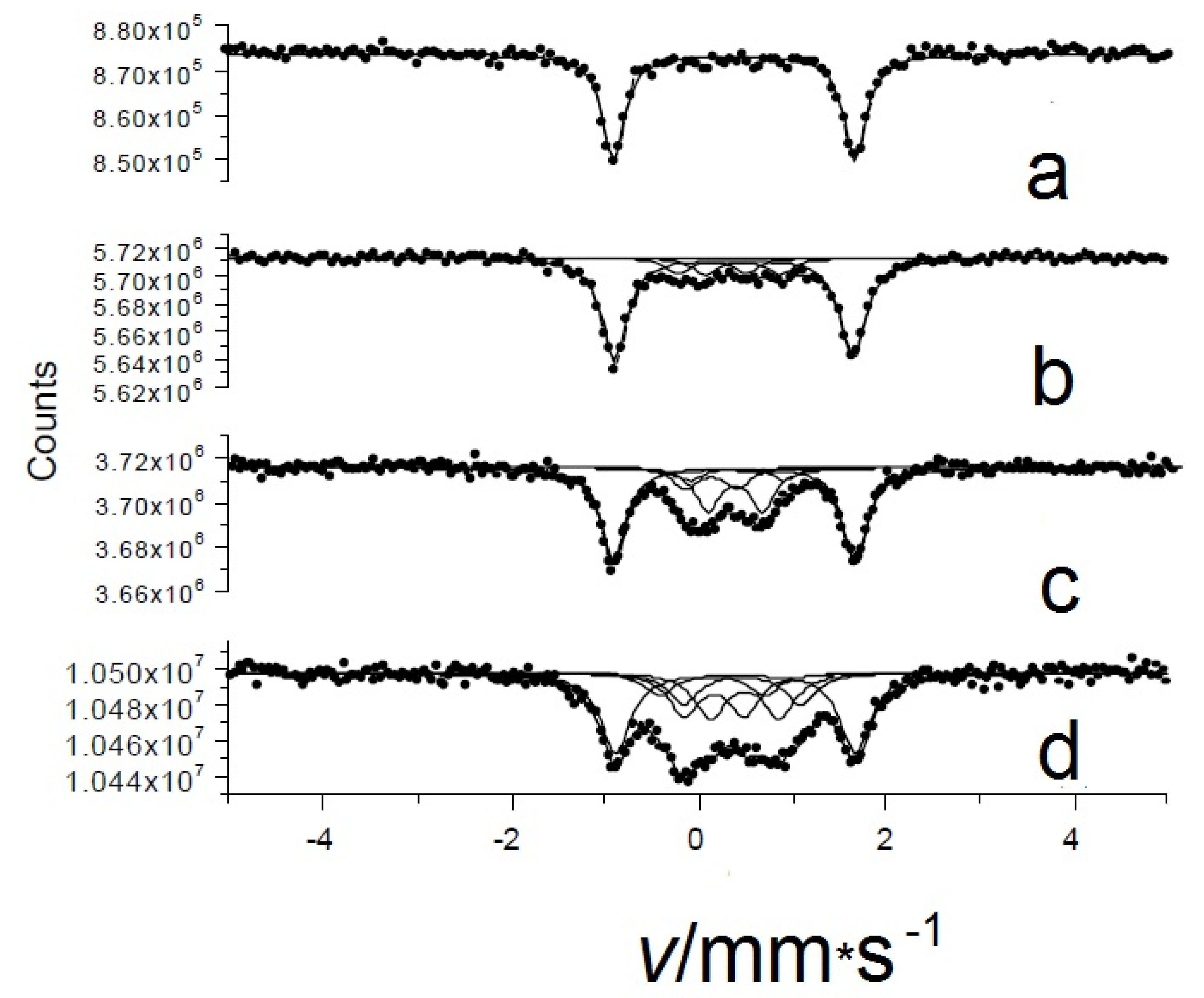
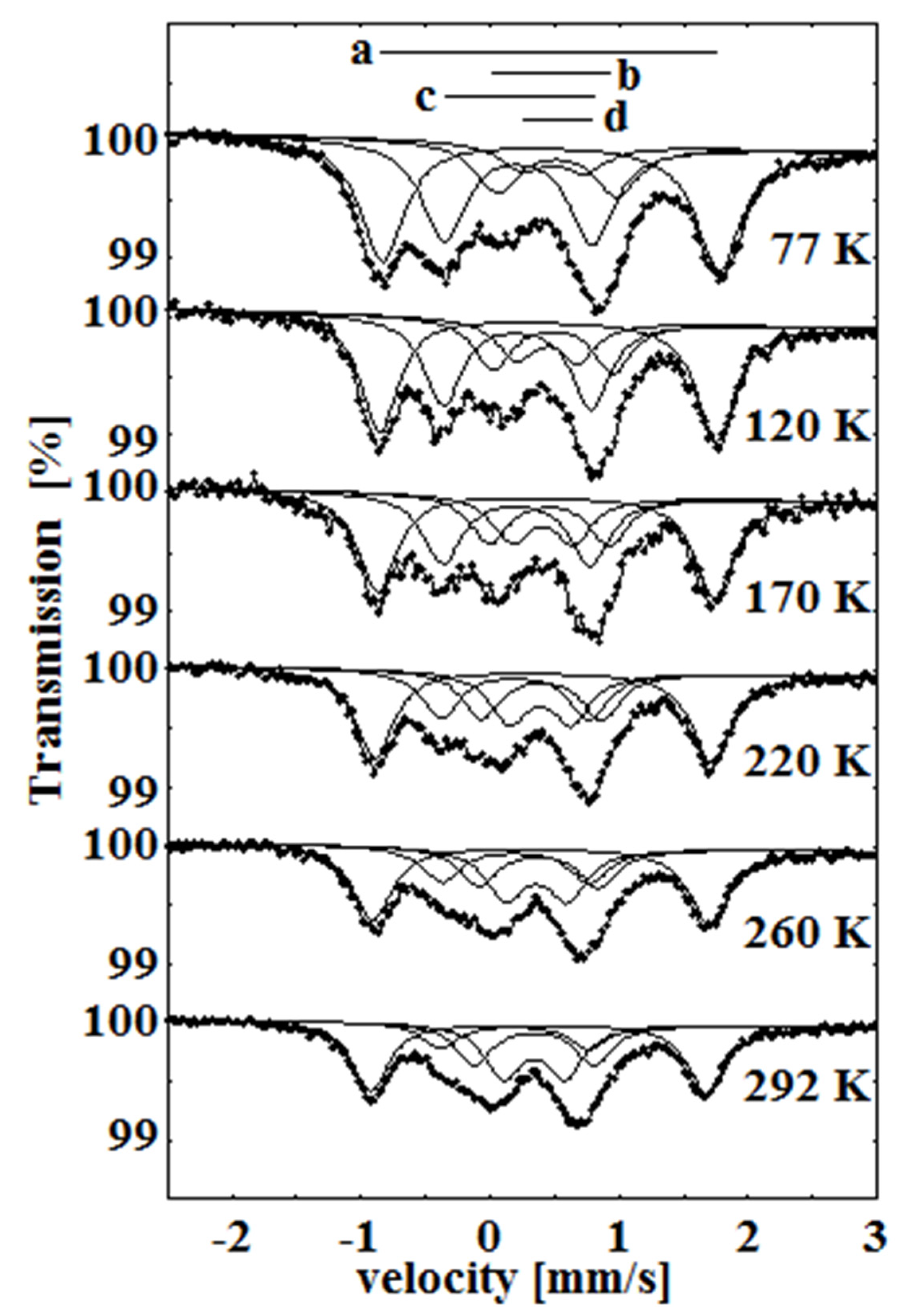
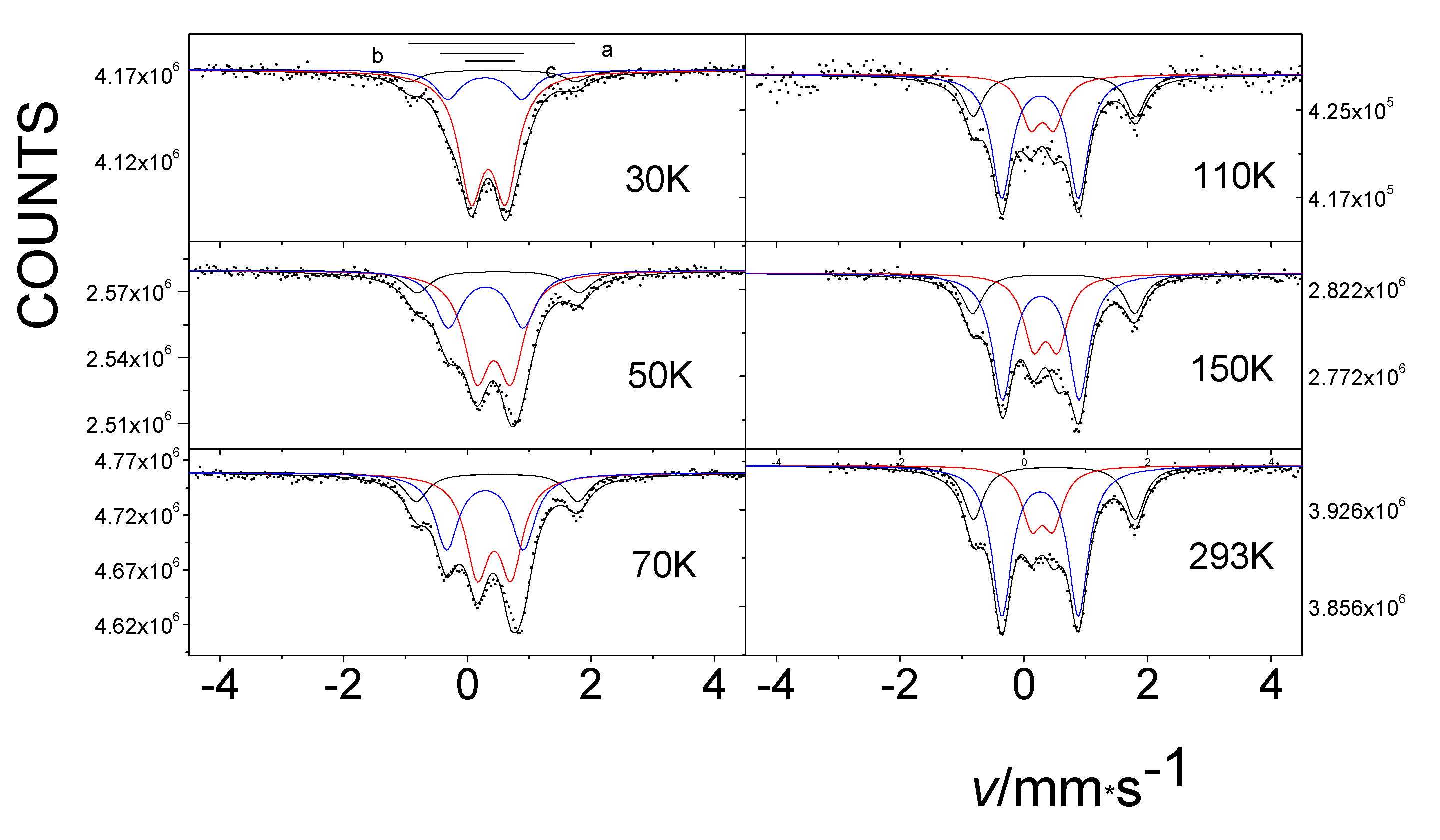
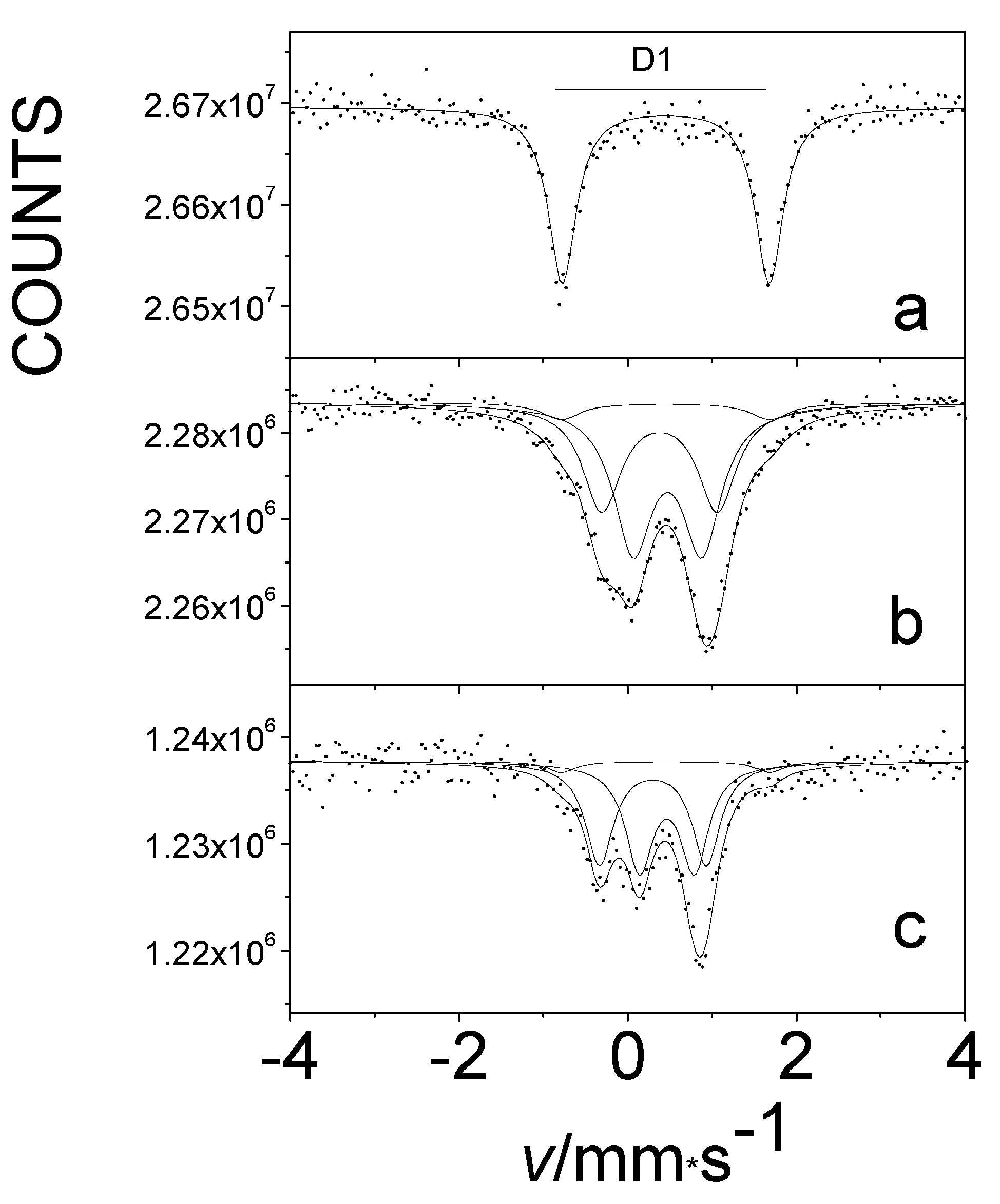



| Compound | Fe(L2)2 | Fe(L5)2 | Fe(L4)2 | Fe(L3)2 |
|---|---|---|---|---|
| N-Fe-N angle, o | 180 | 179 | 169 | 141 |
| Bint, Tesla | 122 | 105 | 92 | 67 |
Publisher’s Note: MDPI stays neutral with regard to jurisdictional claims in published maps and institutional affiliations. |
© 2021 by the authors. Licensee MDPI, Basel, Switzerland. This article is an open access article distributed under the terms and conditions of the Creative Commons Attribution (CC BY) license (http://creativecommons.org/licenses/by/4.0/).
Share and Cite
Kuzmann, E.; Homonnay, Z.; Klencsár, Z.; Szalay, R. 57Fe Mössbauer Spectroscopy as a Tool for Study of Spin States and Magnetic Interactions in Inorganic Chemistry. Molecules 2021, 26, 1062. https://doi.org/10.3390/molecules26041062
Kuzmann E, Homonnay Z, Klencsár Z, Szalay R. 57Fe Mössbauer Spectroscopy as a Tool for Study of Spin States and Magnetic Interactions in Inorganic Chemistry. Molecules. 2021; 26(4):1062. https://doi.org/10.3390/molecules26041062
Chicago/Turabian StyleKuzmann, Ernő, Zoltán Homonnay, Zoltán Klencsár, and Roland Szalay. 2021. "57Fe Mössbauer Spectroscopy as a Tool for Study of Spin States and Magnetic Interactions in Inorganic Chemistry" Molecules 26, no. 4: 1062. https://doi.org/10.3390/molecules26041062







